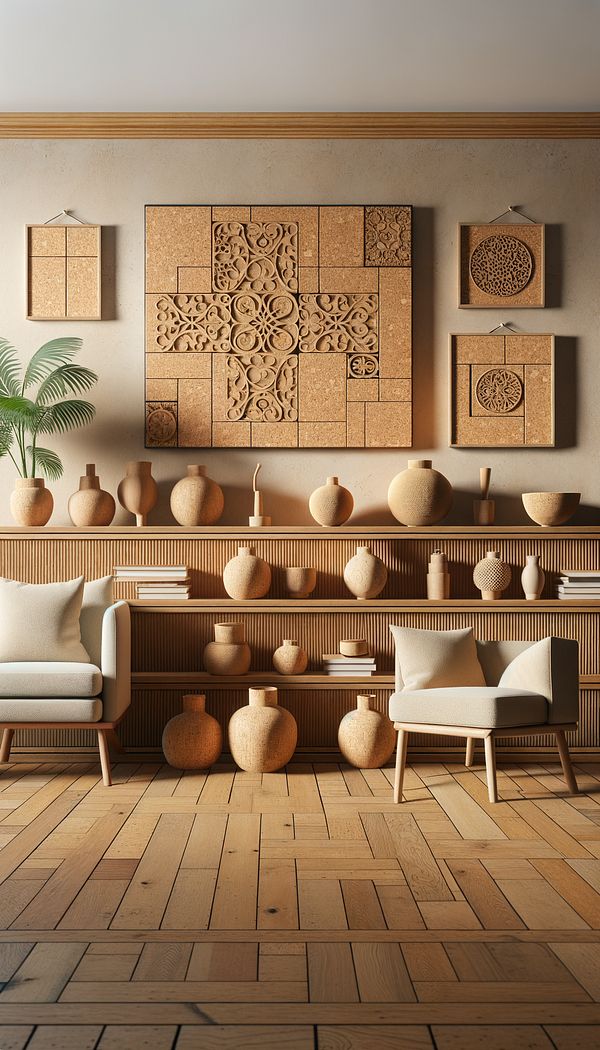What is Cork?
Cork is a lightweight, natural material harvested from the cork oak tree.
Description
Cork is a unique and versatile material widely celebrated in the world of interior design for its remarkable qualities. Harvested from the bark of the cork oak tree (Quercus suber), primarily found in the Mediterranean region, cork is prized for its sustainability, durability, and natural beauty. The harvesting process is environmentally friendly, as the cork oak tree is not cut down but simply stripped of its bark, which then regenerates over time.
Cork's cellular structure makes it lightweight, waterproof, and naturally insulating against heat, cold, and sound. These properties have cemented cork's role in a wide range of applications, from flooring and wall coverings to furniture and decorative items. Its natural texture and warmth make it a favorite among designers seeking to add an earthy, organic element to interior spaces. Furthermore, cork can be finished in various ways, enhancing its versatility in design.
In terms of sustainability, cork stands out as a renewable resource. The cork oak forests contribute to the ecosystem's health by supporting biodiversity, preventing erosion, and storing carbon dioxide. Choosing cork for interior design projects not only makes a statement about style but also about environmental responsibility.
Usage
Cork is utilized in various interior design applications including as flooring, wall treatments, and finishes, decorative objects, and even in the creation of furniture types. Its adaptability and eco-friendly properties make it a popular choice for both residential and commercial spaces. Designers and homeowners alike appreciate cork for its natural aesthetic, comfort underfoot, and acoustic insulation properties.
FAQs
-
Is cork waterproof?
Yes, cork is naturally waterproof due to its cellular structure, which makes it an excellent material for bathrooms, kitchens, and other moisture-prone areas.
-
How is cork harvested without harming the tree?
Cork is harvested by carefully stripping the outer bark from the cork oak tree, a process that does not damage the tree. The bark regenerates over time, allowing for sustainable harvesting every 9-12 years.
-
Can cork be used outdoors?
While cork is resistant to moisture and insulating, it is typically not recommended for outdoor use due to its susceptibility to ultraviolet (UV) rays and extreme weather conditions.
-
How does cork contribute to sustainability?
Cork is a renewable resource that supports biodiversity, aids in carbon dioxide storage, and prevents soil erosion. By choosing cork, you're supporting a sustainable, eco-friendly material.
-
Is cork flooring comfortable to walk on?
Yes, cork flooring is known for its comfort underfoot, offering a soft, cushioned feel that is also beneficial for reducing noise.
-
How do you maintain and clean cork surfaces?
Cork surfaces are relatively easy to maintain. Regular sweeping and damp mopping with mild soap are usually sufficient. Avoid excessive water and harsh cleaning agents.
Practical Application
When integrating cork into your interior design projects, consider its natural charm and functionality. Cork flooring can add warmth and comfort to any room, while cork wall tiles can provide sound insulation and a unique texture. For a cohesive aesthetic, consider complementing cork elements with other natural materials like wood, stone, or leather. And, to preserve the beauty and longevity of cork, ensure regular maintenance and protect it from prolonged exposure to moisture and direct sunlight.
-
Decorative Objects240 articles
-
Materials & Textiles360 articles
-
Flooring & Carpets48 articles
-
Wall Treatments & Finishes157 articles
-
Sustainability & Eco-Friendly Design69 articles
-
Asian Zen StyleAsian Zen Style is a tranquil and minimalist interior design approach influenced by the simplicity and natural elements of Zen philosophy.
-
EmpireEmpire refers to an opulent and majestic interior design style that originated in France during the First French Empire (early 19th century).
-
Abrasion WearAbrasion wear refers to the damage or wear that occurs on a surface due to friction.
-
Art GlassArt glass is a decorative material primarily used for its aesthetic appeal.
-
Log FurnitureLog furniture is furniture made from whole or partially whole logs.
